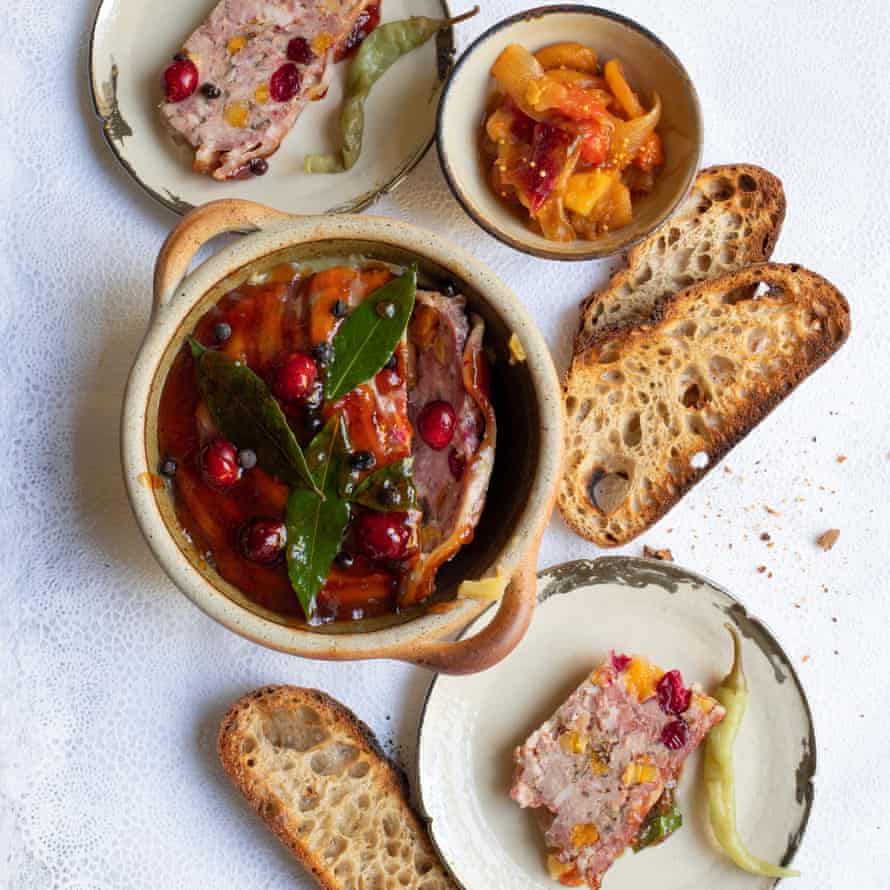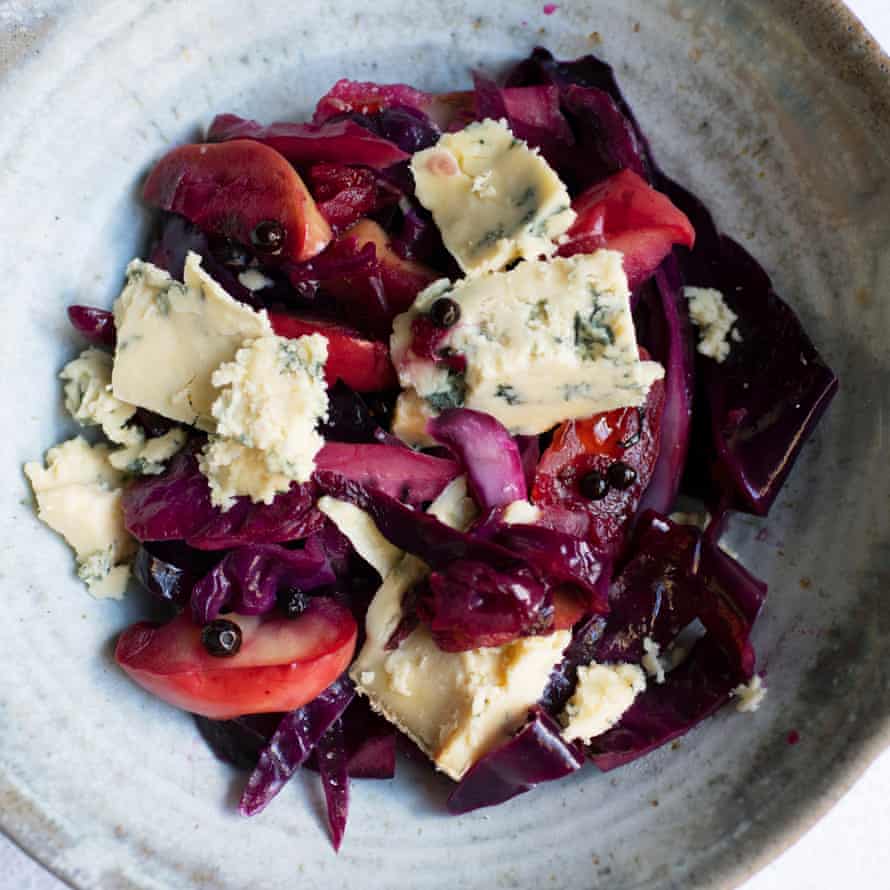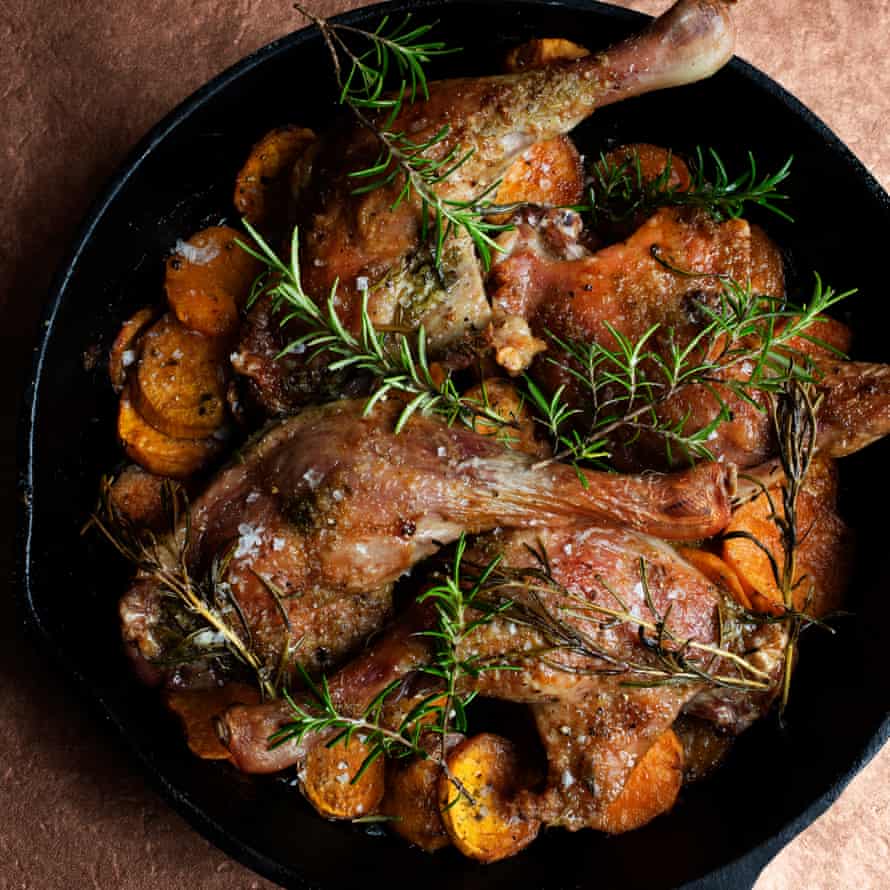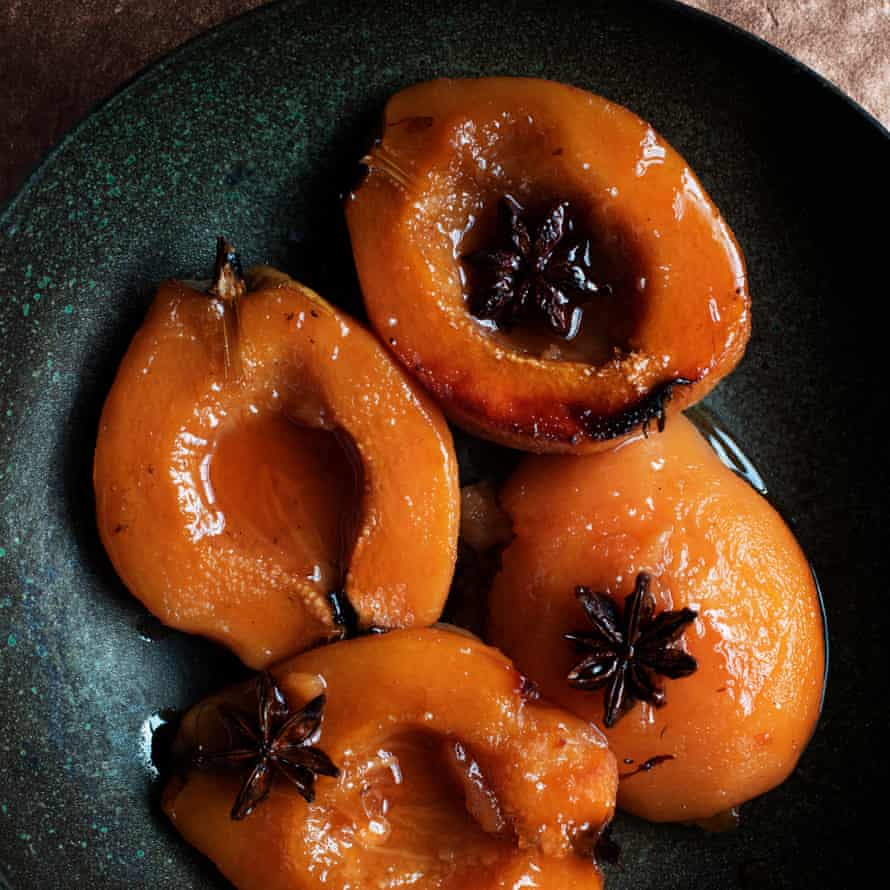I drag a branch into the hallway, a broken bough for a tall pot by the fireplace, its branches adorned with moss tufts and wooden stars. A house gift – a thank you, if you will. This is also where visitors are greeted and served tiny tarts of candied peel and glasses of chilled fino (or perhaps a glass of oloroso the colour of amber). It’s where gifts are exchanged and guests are safely sent on their way.
There’s a lot to be said for having something in the house for everyone. Cake, pies, and a massive tin of Quality Street, of course, but I also like to have something savory and more substantial – a terrine, an earthenware dish of coarse-textured pork paté, is my answer. Something to cut up and serve with toast or oatcakes.
I make chutney too, jars of it to serve with cold meat or nut roast, with wedges of caerphilly or wigmore. A chutney good enough to give as a gift, something to take to friends or simply to have in the house to sit next to a pork pie or a few slices of cold, salt-freckled roast goose. This year’s version was made with dried apricots and cherry tomatoes, a bright and fruity preserve. I could have added a little fresh chilli but left it as it is, in all its sweet sharpness.
A snap of frost, even a few icicles, is never going to put me off making a salad. But the textures in the salad bowl do vary with the days. The soft, buttery lettuce of summer is replaced by crackling leaves of cabbage and chicory, the dressings are thicker and more mustardy; cheese is often present, either in the form of pecorino (so good with pears and cabbage) or crumbled blue.
The season’s other stars – cranberries – wriggle their way on to my Christmas list. For the usual sauce of course, but also to toss into a paté or to perk up the gravy for a Christmas bird. Clementines for juicing on Christmas morning. Quinces, for making jelly if you have the time, to bake or poach, compote style, if not. Walnuts for salads (try them with chicory and beetroot) and chestnuts for roasting (don’t forget to split the casing first or they will explode into nutty shrapnel). The crystallised fruit and candied peel come out now, too.
The goose and turkey remain king of the omnivore’s table, but I like to roast smaller birds at this time too. Partridge or duck are often welcome at the season’s other, smaller occasions. I roast them on a bed of potatoes, basted copiously in goose or duck fat, their juices seasoning the potatoes as they slowly roast.
Candied peel Christmas tartlets (pictured above)
I cannot imagine Christmas without candied peel. The tiny glowing nuggets of candied orange, lemon or grapefruit peel are flecked throughout Christmas cakes and panettone; stirred into ricotta for filling domes of cassata, and used to bring a sparkle to the thick waves of cream and custard that crown a sherry trifle.
The stuff you buy ready-chopped in little drums is fine but I prefer to buy mine by the piece (and for which you need a good Italian deli or a top-notch food hall). The slices of crystallised peel glow like stained glass windows in a church, but they are expensive. I have found most people who say they don’t like candied peel tend to relent when they meet the real thing.
For these little tartlets – an alternative to the mince pie – I use candied orange peel that I buy in December and keep in a stoppered glass jar to use throughout the year. The everyday tubs of peel will do at a push.
Makes 24
For the pastry
butter 150g, plus extra for greasing the tart tins
plain flour 295g
salt a pinch
ice-cold water a little
For the filling
golden syrup 200g
sultanas 75g
candied peel 75g
mixed spice a pinch
butter 25g plus a little extra
soft amaretti or plain, soft cake crumbs 85g
egg 1 large, lightly beaten
You will need 2 x 12-cup mince pie or jam tart tins.
To make the pastry, cut the butter into small chunks and rub it into the flour with your fingertips. It should resemble fresh coarse breadcrumbs.
I sometimes add a pinch of salt. Sprinkle a little cold water over the crumbs and bring them together with your hands to form a soft, but not sticky, ball. Pat the dough into a thick disc, then wrap in kitchen paper and refrigerate for half an hour.
Preheat the oven to 170C fan/gas mark 5. To make the filling, warm the syrup in a saucepan together with the dried and candied fruit, mixed spice and butter, then crumble in the amaretti or cake crumbs. Remove the pan from the heat, then stir the beaten egg into the mixture.
Roll out the pastry and, using an 8cm cutter, cut out 24 discs of the pastry. Lightly butter the tart cases with the extra butter, then place the pastry discs in the tart cases and divide the mixture between them. Bake until pale gold and bubbling – about 15-20 minutes. Let the tarts settle for 10 minutes before easing them from their tins. Dust with icing sugar if you wish.
Pork and cranberry terrine with apricot chutney

There is much pleasure in knowing there is a dish of paté – a coarse, fruit-flecked terrine – in the fridge. As useful as a Christmas cake, something to slice and serve to unexpected guests, or for lunch with thick-cut toast and pickled gherkins. I also made a sweet and sour chutney to go with this one, a pot of ochre-coloured pickle to bring out with this or with bread and cheese.
Serves 8
For the terrine
onion 1 medium
butter 30g
thyme leaves 2 tsp
rosemary leaves 1 tsp
smoked bacon 250g
minced pork 400g
ground mace ½ tsp
juniper berries 12
dried apricots 80g
fresh cranberries 60g
marsala or brandy 2 tbsp
To finish
bacon 2 rashers
bay leaves 4
juniper berries 12
cranberries 6
For the chutney (makes 2 large jars)
red onion 1
yellow onion 1
olive oil 4 tbsp
dried apricots 450g
ginger 25g (a thumb-sized lump)
lemon zest and juice of 1
golden caster sugar 200g
cider vinegar 250ml
bramley 2 large, or other sharp apples
cherry tomatoes 200g, yellow or orange
pomegranate 1
You will need 2 small (500ml) ovenproof preserving jars or a suitable earthenware terrine.
Preheat the oven to 160C fan/gas mark 4. Peel and finely chop the onion. Melt the butter in a deep pan over a low to moderate heat, then add the chopped onion and leave to soften, stirring from time to time. Chop the thyme and rosemary, and stir into the softening onion.
Remove the rind from the bacon, then chop the rashers finely. Put the pork mince in a mixing bowl and add the bacon. Remove the pan from the heat, then add the cooked onion to the minced pork. Season with the ground mace, ½ tsp of salt and plenty of black pepper. Crush the juniper berries using a pestle and mortar. Chop the dried apricots then mix into the pork together with the crushed juniper berries, the fresh cranberries and the marsala or brandy. Check all is mixed well then push into the jars or terrine.
Cover the surface of the mixture with the bacon rashers, tucking them down the side of the jars, then press the bay leaves, juniper berries and cranberries into the surface. Cover loosely with the lid (do not seal with the metal clip) or cover the top with baking parchment, secure with string or a rubber band, then tin foil.
Half fill a roasting tin with hot water, place the jars or terrine into the water so it comes halfway up the sides. Bake for 1 hour and 20 minutes. Leave to cool in the switched-off oven, then remove and refrigerate overnight.
To make the chutney, peel the onions, then halve and cut each half into quarters. Separate the layers of onion. Warm the olive oil in a deep, heavy-based pan. Add the onions and let them cook for 10-15 minutes, or until soft and translucent.
Cut the dried apricots in half and add to the onions, then peel and finely grate in the ginger and the lemon zest. Stir in the caster sugar, then, as the mixture starts to bubble, introduce the cider vinegar. Partially cover with a lid and leave over a low heat.
Peel the apples, quarter and core them, then roughly chop. Add the apples to the pan, then the juice of the lemon. Once the apples start to collapse, halve the cherry tomatoes and stir them in.
Add salt and, if you wish, some coarsely ground black pepper, then bottle and seal. You should get a couple of decent-sized jars out of it.
It will keep, depending on the trouble you go to seal it (sterilised jars, please) for a good few weeks in a cool place. Sometimes I crack a pomegranate and add its ruby seeds to the chutney at the table.
Red cabbage with apple and stilton

The wine vinegar and fruit jelly melts to give a sweet-sour dressing for the cabbage. Sweetness often works rather well with blue cheese, though port has never rung my bell. Better, I think, are sweet white wines, even muscats.
Any blue cheese is a friend to cabbage – a favourite winter salad of mine involves tossing shredded white cabbage with slices of pear and smoked, salted almonds. A pale, crisp and nutty accompaniment.
Serves 2-3
red cabbage 600g
juniper berries 8
apples 2
groundnut oil 3 tbsp
white wine vinegar 150ml
quince, apple or redcurrant jelly 3 tbsp
blue cheese 200g, such stilton or stichelton
Finely shred the cabbage and wash it in cold water. Crush the juniper berries with a heavy weight, such as a mortar or the end of a rolling pin. Cut the apples in half, then into segments, coring them as you go.
In a large pan, warm the groundnut oil over a moderate heat then add the cabbage, juniper berries and apple, letting them cook, stirring from time to time, for about 10 minutes until the cabbage has started to relax and the apples are tender rather than crisp.
Pour in the white wine vinegar and let it sizzle. Add the fruit jelly and stir so that it melts and lightly coats the cabbage. Lift out with a draining spoon on to a serving dish. Crumble the cheese over the cabbage and apple, and serve.
Roast duck with sweet potatoes and rosemary salt

Roast duck with sweet potatoes and rosemary salt. Photograph: The Observer
I could devour duck fat on toast, spread thick like butter and sprinkled with a few flakes of sea salt. A pot of it in the fridge is particularly useful at this time of year – use it instead of olive oil to baste meats in the oven – it is especially good with chicken, spread over the skin before roasting. Potatoes that are cooked in it soak it up, then crisp deliciously. Seasoned with thyme or rosemary and plenty of salt, there is almost no better cooking medium for roasting a bird. Of course, goose fat – even better – will be along soon, stored in a pot in the fridge both will keep for several weeks.
Serves 4
duck legs 4
rosemary leaves 4g
sea salt 1 tbsp
sweet potatoes 800g
duck fat 4 tbsp
The night before, remove the duck legs from any packaging, place on a tray or dish and refrigerate, uncovered, overnight. This will dry out their skins and help them cook crisply.
Put the rosemary leaves and sea salt in a spice mill or food processor and process to a coarse green powder – you could use a pestle and mortar if you prefer. Rub the duck legs with a little of the duck fat then rub the herb salt into them.
- Confusion Regarding WASSCE Results
- Papua New Guinea, experts fear, could be a breeding ground for new Covid strains.
Preheat the oven to 160C fan/gas mark 4. Peel the sweet potatoes and cut them in 1cm thick slices. Rub a roasting tin or baking dish large enough to take the duck legs with the remaining duck fat, then place the slices of sweet potato, slightly overlapping, over the surface. You may have enough for two or three layers, depending on your dish. Place the seasoned duck legs on top of the pota
toes and place in the oven and leave for 50 minutes or until the duck is nut brown and crisp. Remove the duck and set aside in a warm place to rest.
Turn the oven up to 200C fan/gas mark 8. Holding the potatoes in place, carefully pour most of the duck fat into a bowl for another time, leaving a couple of tablespoons behind in the tin. Return the roasting tin to the oven for 10 minutes. You should get a little browning on the surface of the potatoes.
Serve the duck with the sweet potatoes, spooning over any juices and duck fat remaining in the pan.
Baked quince with maple syrup

Advertisement
Quince graces us with its presence throughout the winter but is probably most abundant at Christmas. The fruit – deep yellow, fragrant – sit patiently in a blue and white bowl on the kitchen counter, waiting for me to turn them into jam. They are a cooks’ fruit, like gooseberries, damsons and rhubarb, and need both heat and sugar, or perhaps honey or maple syrup, to sweeten them.
I bake mine, but like to poach them first in a light syrup. A quince is only good when it is so soft it is on the verge of collapse. They respond to sugar but also cloves, cinnamon quills and stars of anise, the prettiest of all spices.
Serves 4
caster sugar 8 heaped tbsp
water 1 litre
quince 2 large
lemon 1, halved
cloves 3
maple syrup 4 tbsp
star anise 2
In a deep saucepan large enough to take the quince, bring the sugar and water to the boil and add the cloves. Peel the quince, rub all the cut sides with lemon, and halve them from stalk to base. Using a teaspoon, remove the core and seeds to leave a small, deep hollow.
Put the quince into the syrup – they should fit snugly – and lower the heat to a simmer. Leave them to cook till soft and thoroughly tender, a matter of a good 30-40 minutes, depending on their ripeness. Remove from the heat and set aside in their syrup. (You can bake them now, or refrigerate and cook later.)
Preheat the oven to 160C fan/gas mark 4. Using a large spoon, transfer the quince to a roasting tin or baking dish, cut side up. Pour over 150ml of the cooking syrup and the maple syrup. Add the star anise and bake for 30 minutes. Turn the heat to 200C fan/gas mark 8 and continue cooking for 10 minutes to reduce and slightly thicken the syrup.



